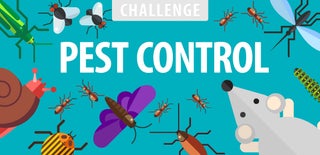Introduction: FROM PEST TO FISH FOOD!
Wasps, hornets, mud daubers and bumble bees can be a real nuisance, if they move in close proximity to your residence.
Step 1: OBSERVING THE PESTS IN ACTION
There was a 3/16” gap between the top of my house siding and the soffit (overhang) molding. A considerable number of wasps had decided to make their home down between the exterior wall sheathing and outer vinyl siding. I called a local bee keeper and then my local extension service for help. They informed me there was no value in saving these invaders and that I should be extra careful in trying to remove them. Besides the possibility of getting stung multiple times, I thought about what environmental and staining damage I might do to my house by spraying poison in this crevice. I then developed a safe and thorough process that can be accomplished requiring two people.
Step 2: GATHERING THE REQUIRED MATERIALS TOGETHER
A Shop Vacuum (Wet /Dry Vac)
1 - Electric extension cord
2 – 2"x 4" boards 3 feet long (One cut with a 45 degree angle on one end.
1 – 2"x 4" board 6 feed long (I cut a vee in one end)
1 – 2” PVC Pipe 10 feet long
1 - Roll duct tape
2 – Gallons of water and only one drop of dish washing liquid
10 – Drywall screws 2-1/2” long
A Flashlight with good batteries
An electric drill with a Phillips bit to drive the screws
Step 3: PREPARING THE VACUUM
Remove the paper filter out of the shop vac. Pour in the water and add the one drop of dishwashing liquid. (The soap will break the water surface tension causing the pests to drown.) Put the vacuum top back on.
Step 4: ASSEMBLING THE PIPE SUPPORT
Assemble the 2x4 lumber with the drywall screws, like the drawing above. This will be used to hold the PVC pipe in place.
Step 5: STAGING THE ATTACK
Duct tape the 2” PVC pipe to the end of the shop vacuum hose. Take all the parts outside at a safe distance from the little critters hole. Plug the vacuum into the extension cord and the extension cord into an outside outlet well away from the action. Now, wait until it has been dark for a few hours. The wasps will be dormant but there it always one guarding their entrance.
Step 6: REMOVING THE PESTS
When it is time, one person holds the light while the other turns on the vacuum and holds the suction end of the PVC to their hole. CAUTION – These pests might be drawn toward the light, so be sure not to shine them directly. (Red cellophane over the lens helps.) The person that was holding the light now uses the duct tape to bond the PVC pipe into the vee end of the 2x4. Your suction device should now be stable. Let it operate for 15 minutes. Unplug at the house end of the extension cord. Wait for 10 minutes, then go out and plug the cord in again. Use a broomstick to lightly tap on the outside of the siding to draw attention. You will hear them being drawn into the vacuum – pfft! pfft! pfft! They will all drown in the shop vacuum water. (Do not forget to later seal the hole they were populating.)
Step 7: WHAT TO DO WITH YOUR BOUNTY
I poured my wasp laden water from the shop vacuum into a bucket and then walk to a pond down the street. I spread the contents over the surface of the pond and take the greatest pleasure in seeing the fish gobble them up!
Step 8: DEALING WITH GROUND PESTS
In the past, I encountered a nest of bumble bees in the ground. For those, I set up the vacuum and PVC pipe with a tee fitting on the end. Using a cement block to keep the tee positioned over the hole, I stomped and danced all around their entrance. They too went - pfft! pfft! pfft! and all the little fish went - yum! yum! yum!

Participated in the
Hack Your Day Contest

Participated in the
Pest Control Challenge












